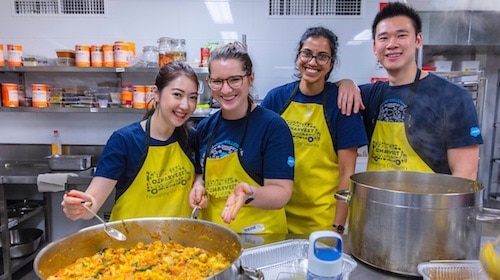Ever learned something new about a colleague during an office happy hour? Whether it’s learning that your coworker has a cool hobby outside of work or that your boss has some impressive dance moves, the number-one reason employees attend happy hour is to get to know their colleagues better.
But happy hour isn’t the only way to learn about your coworkers outside of work — and it might not even be the best way. Increasingly, companies are finding that volunteering is better than a happy hour for many reasons. Not only does volunteering do a better job at bringing employees together, but it can also build the brand, engage and retain staff, and even help develop new skills — not to mention give back to local communities. Read on: It might just be time to set down the drink and pick up a shovel. Here are our top reasons we say volunteering is the new happy hour.
1. It helps break down barriers
As with a company happy hour, volunteering gives employees who otherwise wouldn’t meet a chance to work together and get to know one another. This goes for rank-and-file staff from departments that don’t otherwise interact, but it also crosses the hierarchical barriers that exist in the workplace. For many people, approaching executives and leaders is intimidating, no matter the setting. But with volunteering, the tasks are generally pretty simple, putting everyone on an even playing field and giving everyone a common goal. Conversation flows a little easier when everyone is zeroed in on the task at hand, whether that’s serving a meal, helping young children to read, or cleaning up a local park.
2. The joy from volunteering lasts longer — and so do your employees
One simple benefit of happy hour is right there in the name: It makes employees happy. Employee volunteerism also makes employees happy, and that happiness has benefits for a company’s retention and recruitment efforts. There’s a positive relationship between volunteering and employee engagement: 92% of employees who support pro bono projects at work report being happier. Consider this: According to Great Place to Work, companies with happy employees experience three times the revenue growth and three times better stock market performance.
3. It helps employees develop new skills
Another distinctive aspect of volunteering is that it creates opportunities for employees to develop new skills, hone existing ones, and maybe even show off a skill nobody knew you had. An engineer, for instance, might coordinate a STEM education event with a local school. He or she would plan the curriculum, develop a budget to purchase materials, and deliver the event to the students. This would exercise project management, financial planning, and presentation skills — allowing the engineer to develop or improve upon these skills and possibly show colleagues and higher-ups some abilities they might not otherwise get to see.
Pro bono volunteering similarly enables employees to hone some of their technical chops outside of a work context. For example, a marketing professional could offer to develop promotional materials for an animal shelter’s upcoming fundraiser. Managers can volunteer to advise nonprofits on writing a business plan or recruiting board members, or even embark on long-range succession planning.
4. It improves team dynamics and refines soft skills
Managers and subordinates don’t often get to walk in one another’s shoes, but volunteering provides a unique opportunity to do just that. The changes in role play can, to some extent, provide opportunities for subordinates to test or develop skills they don’t otherwise use. In addition to rank-and-file employees trying out their leadership skills, there are also opportunities for people who typically work on their own to try their hand at collaboration, developing skills in motivating and persuading their peers. Others may find empathy for those who perform a less desirable or highly demanding role in the workplace. This type of change in perspective can help develop critical soft skills that bring teams closer together and make them more successful.
5. It lets you keep the endgame in mind
When workplaces volunteer together, they’re working to accomplish one common goal. Despite everyone’s best intentions, that’s not always the case at work. The volunteer setting forces everyone to get on the same path and look to the same objective — whether it’s a project-based objective, like running a toys-for-tots drive, or a permanent one, like building a playground for the community. The volunteering objectives often align to a bigger purpose for the business, binding all participants to that common goal or outcome.
Keep the goodwill flowing
Programs emphasizing the value of volunteering provide benefits for communities, corporations, and individual employees. Like happy hours, volunteering makes for stronger connections, happier employees, and even some unexpected opportunities. And while we love the idea of workplace volunteering, who’s to say you can’t have a happy hour after your next volunteering event?
To learn how you can instill a volunteering culture in your company, check out some of our latest blog posts or download our Salesforce.org Philanthropy Cloud Volunteering Solution Brief. Philanthropy Cloud is Salesforce.org’s platform for enterprises that helps turn everyday employees into citizen philanthropists by empowering them to volunteer, give back, and make change through their workplaces.




























